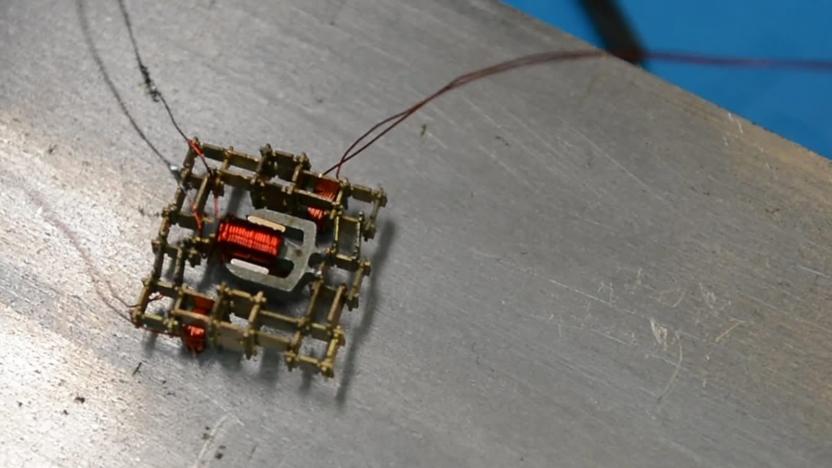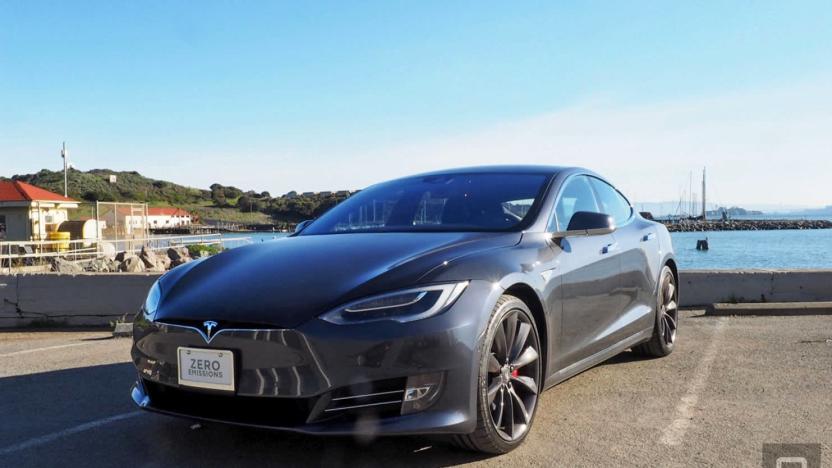motor
Latest

The 2024 Polestar 2 will have better range, stronger motors and a SmartZone sensor suite
Polestar on Tuesday showed off some of the numerous updates that the upcoming 2024 model year PS2 will sport: new motors, new standard equipment, new battery chemistry and the SmartZone sensor suite.

Porsche tests a four-motor powertrain for electric SUVs
Porsche's follow-ups to the Taycan may make its powerplants seem conservative by comparison. The Stuttgart crew has revealed that it's working on a four-motor powertrain for electric SUVs, twice as many as what you'll find in the Taycan. This isn't about improving quarter mile times, though. Instead, the design is focused on control -- one motor for each wheel lets Porsche rapidly shift the power distribution based on where it's needed, whether it's to counteract slippery roads or take corners at high speed. You could have the "agility of a sports car" in a large people carrier, the company claimed.

Tiny 'walking' motor could help robots build other robots
How do you get better at making more robots? By rethinking how you build the manufacturing robots, apparently. MIT researchers have developed a minuscule "walking" motor that allows for robots which should be at once customizable, fast and inexpensive. It's made of just five modular parts, including rigid and flexible components, electromagnetics, a coil and a magnet. Those move an appendage that lets the robot crawl, grip, push and otherwise perform tasks without a complex set of parts -- it's likened to a "micro-Lego" that can be configured to do what you want with a minimum of fuss.

BMW and Jaguar Land Rover team up on electric vehicles
Jaguar Land Rover and BMW are partnering to build a new generation of motors for the pair's electric vehicles. Both companies will jointly develop the technology, and work to use their combined size to make component purchases cheaper. But each business will build their own engines at their own plants, in the UK and Germany.

Tesla may outfit Model S and X with longer-range motors
Tesla's Model S and Model X sales fell sharply at the start of 2019, but the company might have a way to entice hesitant buyers: give them the range they're asking for. Electrek sources claim the brand is planning to outfit its older EVs with new motors based on the same permanent magnet reluctance technology you find in the more recent Model 3. While the exact specs aren't available, the greater efficiency of PMR (97 percent versus 93 percent for the current AC induction motors) would likely wring out some extra range without noticeable compromises to the design.

Virgin Galactic donates SpaceShipTwo rocket motor to the Smithsonian
You might see a piece of private spaceflight history on display when you visit Washington, DC in the future. Virgin Galactic has donated SpaceShipTwo's (VSS Unity) historic rocket motor to the Smithsonian National Air and Space Museum. This is the powerplant that took the craft into space for the first time this past December, and represents both "technical achievement" as well as proof of what you can do through "entrepreneurial innovation," according to museum director Ellen Stofan.

MIT fires a rocket motor made using 3D-printed plastic
If you're going to 3D-print rocket parts, you'd want to make them out of metal to handle the stress, right? Not necessarily. MIT has successfully test-fired what it believes is the first completely 3D-printed rocket motor to be made with plastic casing. That's right -- an all too easily melted material was sitting a virtual hair's breadth away from super-hot propellant. It sounds like a recipe for disaster, but apparently it worked well -- it generated real thrust, and there was only a small amount of damage to the motor's throat after the initial run. A second test didn't fare so well (it would be useless for moving anything), but MIT hadn't intended for the motor to fire more than once.

France isn't ready to ban cyclists from cheating with motors
The pro cycling world may be cracking down on the use of hidden motors to cheat in races, but it doesn't look like governments are ready to make it a criminal offense. The French government has shot down a proposed law that would have made this "technological doping" illegal, adding legal penalties to the punishments from racing leagues themselves. It's not that the politicians endorse cheating, of course. Rather, it's that they feel the proposal was premature and potentially too harsh given existing measures.

Super-fast magnetic motor keeps tiny satellites on track
Satellites often rely on reaction wheels, or constantly spinning flywheels, to tweak their attitudes without using precious fuel. However, they tend to be very delicate -- since they use ball bearings, they spin relatively slowly (under 6,000RPM), take up a lot of space, need tightly controlled environments and aren't very precise. Thankfully, researchers at Celeroton have a better way. They've created a magnetically levitated motor that achieves the effect of a regular reaction wheel with virtually none of the drawbacks. Since its rotor floats in a magnetic field, it can spin much faster (up to 150,000RPM) without wearing out, creating vibrations or requiring a special, lubricated environment. And given that it produces the same angular momentum as a much larger reaction wheel, it's perfect for CubeSats and any other tiny satellite where internal space is at a premium.

Honda unveils first hybrid motor without heavy rare earth metals
Honda pledged to reduce its use of rare earth metals a decade ago, and the automaker took another step towards that goal this week. It unveiled its new hybrid motor that was co-developed alongside Daido Steel, another Japan-based company. The new motor doesn't use heavy rare earth metals like dysprosium and terbium, instead relying on magnets from Daido Steel that cost 10 percent less and weigh 8 percent lighter than the previous components. In fact, the automaker is the first to develop a hybrid motor that doesn't use the heavy metals. Honda says the new engines will reduce its reliance on the pricey rare earth metals that are primarily supplied by China.

Tour de France will use thermal cameras to spot hidden motors
For decades, the world of cycling has struggled to come to terms with the amount of doping in the sport. Lance Armstrong leads a long list of athletes who have used performance-enhancing substances to win, but in recent years, technology has given rise a new form of cheating: hidden motors. With the world's most famous cycling race just a few days away, Tour de France officials will utilize thermal cameras to detect so-called "mechanical doping," putting would-be cheats on notice.

Watch a GPS-assisted boat motor keep ships steady
Driving a motorboat can be scary if you're a newcomer. Despite all that power, you're still at the mercy of the wind and waves -- it can be hard to keep your boat steady when you're docking or waiting for a bridge. Mercury Marine may just save your hide (and your hull), however. It just showed off the results of its smarter Verado outboard motors, which use Skyhook's GPS technology to keep your boat steady and on course. The effect, as you'll see below, is almost eerie: a craft that would drift on its own suddenly stays put thanks to the pivoting engines.

World's smallest nanomotor can pump drugs into cells at 18,000 RPM
Scientists at the Cockrell School of Engineering in Texas have created a nanomotor less than one micrometer in diameter, smaller even than a cell. Powered by electric fields, it consists of a nanowire, magnet and electrode and can spin at a terrifying-sounding 18,000 RPM for over 15 hours (see video below). That's as fast as a jet engine, but don't worry (much). During testing, it showed the ability to pump fluids at hyper-fast speeds and to move around freely in other liquids. That opens up beneficial applications like highly controlled insulin delivery, or devices that could specifically target malignant cells. Of course, that would mean you'd have to let intelligent nano-devices with mini-saws roam about your body -- I guess you're allowed to be a bit terrified.

MIT 'microthrusters' are the size of a penny, could reposition tiny satellites
Bus-sized satellites require massive engines for even the slightest movements, but as far smaller structures become a possibility, a tiny driving mechanism can offer usable thrust. To serve this next-gen tech, MIT saw a need to develop "microthrusters," which are each the size of a penny and can be mounted to tiny cubed satellites. With thruster components measuring a few microns each, the magnetic levitation system is able to accommodate 500 microscopic tips that emit ion beams in a very small package, serving to push two-pound structures through space. The tiny devices have not made their way into orbit yet, but they have been tested in a vacuum chamber. Because of their size, it's possible to add several to each satellite, then enabling sophisticated movements for more precise turns. There are currently two dozen "CubeSats" in orbit, each measuring only slightly larger than a Rubik's cube, but without any thrusters to power them, positioning can't be adjusted once they're released. Because of their current location, CubeSats eventually burn up in the atmosphere, but once they're released farther from Earth, they won't be able to enter the atmosphere on their own, remaining in orbit as "space junk" even after completing their missions -- micro thrusters could also serve to move these satellites closer to the planet so they can burn up during re-entry. There's no word on when, or even if, MIT's invention will make its way to the launchpad, but you can take a closer look in the demo video after the break.

Dyson's engineers head off to the races, create dragsters using spare parts, DC-16 motors (video)
Dyson engineers certainly know a thing or two about creating innovative vacuums and fans Air Multipliers, but did you know they've also dabbled in the world of high-speed racing? Such is apparently now the case, as these folks were tasked with building go-kart drag racers out of spare parts, resulting in a variety of wheeled wonders viaing for the fastest run on a makeshift strip in the office. Of course, there was a catch -- all of the dragsters had to use the motor from Dyson's DC-16 handheld vacuum in a battle for maximum torque. We won't spoil the outcomes for you, so scroll down to catch a video mashup of all the hijinks in the video below.

Teagueduino used to create analog shoebox video game
Most game developers are locked in a tiring, endless technological arms race -- but not Teague, a Seattle-based tech design firm. Using their proprietary Teagueduino software, the team created an analog video game in a shoebox. It's about as Lo-Fi as things get; and it's ridiculously charming.

Amphibious Aquapod might be the clumsiest robot ever (video)
It may look like nothing more than a random piece of seaside trash, but that ugly little creature you're staring at is actually known as Aquapod -- an amphibious robot that crawls around by falling over itself. Literally. Developed by researchers at the University of Minnesota's Center for Distributed Robotics, Aquapod uses two carbon fiber arms and a servo motor system to somersault itself around, like an inebriated horseshoe crab. It's certainly not the swiftest of bots, but this guy's durable enough to move across rough terrains and, per its nickname, is completely waterproof and in full control of its buoyancy. Creators Andrew Carlson and Nikos Papanikolopoulos say their $2,000 brainchild could one day be used to monitor fish populations and conduct underwater experiments -- or to simply scare the bejesus out of beach-going children. Video after the break.

Swiss rocketeer jetpacks above Grand Canyon, lives to tell the tale (video)
There's "crazy" and then there's "craaazy." Crazy is going swimming five minutes after eating, or wearing white after Labor Day. Craaazy, on the other hand, is Yves "Jetman" Rossy -- a Swiss flight fanatic who jetpacked across the Grand Canyon at 190-mph yesterday morning. Rossy's suicide mission began inside a helicopter hovering some 8,000 feet above the canyon's floor. After hurling himself out of the chopper, Jetman ignited his four-motor jetpack and, using his body as a rudder, gently steered himself across the abyss. The daredevil proceeded to coast for a full eight minutes at just 200 feet above the canyon ridge before he presumably realized that he was flying above the Grand Canyon and decided to parachute down to the bottom. Rossy completed the flight with his physical health fully intact, though his mental condition remains up for debate. Blast past the break for a video that'll throw your acrophobia into overdrive.

Saab chooses UQM motors for its 9-3 ePower EV, will be carving Alp twisties soon
Saab announced it was working on an all-electric version of its 9-3 wagon late last year, dubbing it the ePower. Now we're learning what's driving it. The vehicle will be powered by a 135kW UQM Technologies PowerPhase system, an equivalent of 181hp that will propel the car to 60 in 8.5 seconds -- no Huayra but pretty peppy for an EV. Top speed is 93mph and the car's range is expected to be 200km, or about 125miles. Interestingly Saab is eschewing more advanced water-cooled battery tech, like that found in the Volt or Model S, and going for an air-cooled design, despite even the classic 93 of the '50s being water cooled. The company has indicated this will cut costs and promises the battery will still operate at full power even when temperatures drop below -22F. We'll find out soon, as early cars are set to hit Swiss roads sometime in the coming months.

Toyota developing new type of electric motor in an effort to escape dependency on rare earth metals
Toyota's not too pleased with the general scarcity of rare earth minerals and China's near-monopolistic grip on the world's supply, so it's decided to act before it's too late. A company spokesman has been cited as saying the Prius maker is hard at work on a new electric motor design that should dramatically reduce (though seemingly not eliminate) the need for rare earths in its production. Aside from being made of less price-volatile materials, the new electric ticker is expected to be generally cheaper to manufacture. Further details aren't yet available, but we hope this turns into a classic case of necessity breeding innovation -- that Prius C concept deserves a set of internals that can keep up with its bodacious exterior.










